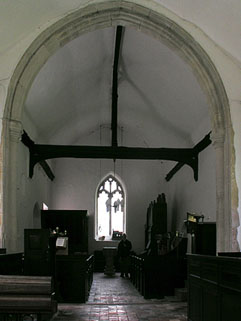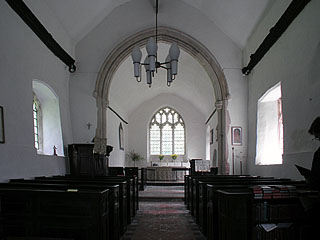St Peter is a diminutive building: tiny nave and chancel, no tower, aisles or any adornment save for a nice little Victorian half-timbered porch on the south wall and a similarly dated bell-cote at the west end. It sits in an uneven green churchyard looking rather uneven itself – this is one of those buildings that time has slowly disarranged so that none of the walls stand quite straight. Built of rubble and fieldstones, it looks impressively ancient.
Not that it is particularly ancient: aside from those Victorian additions St Peter dates from the 14th and 15th centuries, and there are churches far older than that in Cambridgeshire. It is hard to escape the sensation of time pressing down, nonetheless. The interior is white and bare, like bleached bones, and the blackened timbers of the kingpost roof undulate as though warped under many years of strain.
So, save for the hand of time, what did we see in St Peter, on the sunny spring morning we visited? Not much, admittedly: the church is rather empty within. The pulpit is 17th century, but not very interesting. The 15th century font is a bit more unusual. In the north and south faces of the octagonal bowl there are carvings of shields containing symbols of the passion: pairs of hands and feet surrounding a little heart. The effect is both comic and a little grisly.
Next to the font, on the sill of the west window, sits a primitive-looking head – perhaps a lost gargoyle, since it was weathered almost beyond recognition. A sign also informed us there that the bells are medieval.
Wandering towards the chancel, we noticed an odd little niche in the south wall of the nave. It resembles a diagonal squint but doesn’t look like it was ever open all the way through to the exterior. Besides which, it points towards the west end of the interior, rather than the high altar: given that most squints were built to allow a clear line of vision to the east end, we found it quite mysterious. Mark suggested that it could have supported a beam, which seems possible but again inexplicable. Very odd.
The chancel arch is large and (by comparison with the rest of the building) elaborate: the responds both have crenellated capitals at the top, and there are heads on either side of the arch. The chancel itself is also relatively large, though no grander than the nave. The east wall leans outwards alarmingly, and contains a good Perpendicular window.
The old priest’s door in the south wall has been blocked up, producing a recess that reminded me of a little grotto, for some reason. Next to it, in the westernmost window of the south wall, is St Peter’s one remaining piece of medieval glass – a roundel, in the tracery at the top, containing a pair of feet and an orb. Another incongruous image: they did like their feet here in Carlton…
St Peter was open when we visited.


